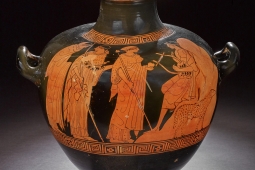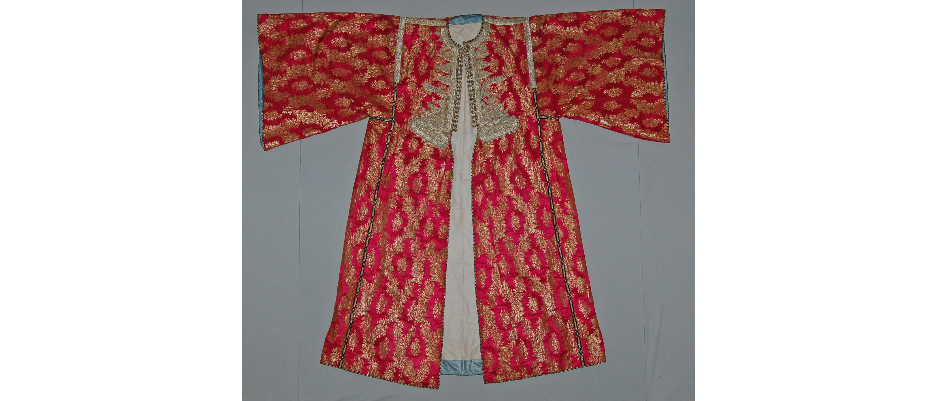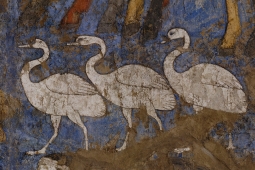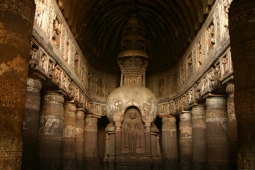Cultural Selection: Chinese, Sogdian, and Byzantine Influences on Caftans Uncovered from Archaeological Sites along the Silk Roads
Depiction of Solar and Lunar Gods wearing double-lapel caftans, from Fondukistan monasteryA caftan is a variant, or style, of robe which may be made of wool, cashmere, cotton, or silk and often bound with a sash. It can be worn as a coat or overdress down to the ankles, usually with long sleeves. The garment has been adopted and worn by a vast number of cultures across the regions encompassed by the Silk roads for thousands of years and has occupied a diversity of positions of social significance and taken on many regional variations. Worn by both men and women, the caftan is thought to have originally been specific to Central Asia, and potentially of Mesopotamian origin, before quickly spreading across Eurasia and widely adopted in a variety of locales by the 1st millennium CE.
The popularity of the caftan, or at least it’s wider adoption, may have begun in West Asia, in Persia and Byzantium where it was considered ‘foreigner attire’. It soon spread to the Northern Caucuses and Central Europe reaching as far as Scandinavia. Some cultures considered the caftan, particularly ones made of silk with its associations with foreign luxury, attire for the elite. For example, in China ‘foreigners dress’ or hufu became very popular for high class men and women during the Tang Dynasty (618 – 907 CE).
Indeed, caftan style and design often reflected the close contacts between different societies along the Silk Roads. A number of examples of caftans uncovered at sites from a variety of different regions reveal the extent of these cross-cultural influences and exchanges, often reflected in design motifs, the materials used, and the context in which the clothing was exchanged and worn. Caftans have been found at numerous burial sites, often clothing those contained within then. For example, at an Alan burial site in the North West Caucuses dating from 600 - 800 CE, 16 complete silk caftans have been uncovered. The origin of the silk is a mixture of Sogdian, Chinese, and Byzantine with the caftans themselves believed to have been payment for local customs duties. One of these 16 caftans, which were probably gifted to an Alan chief, features a design emblematic of the rich exchanges of the time, a mythological creature of Sassanian origin, the simurgh - a creature with the head of a dog and body and claws of a lion, which is featured on a repeated pattern contained within roundel medallions. Roundels of this kind were a very popular design found on numerous goods traded along the Silk Roads, particularly on textiles. The spread of the pearl roundel design was aided by the movement of Sogdian merchants along the Silk Roads across Central Asia.
Furthermore, a caftan was found in a grave (possibly Sogdian) in the Tarim Basin dating from sometime between the 3rd - 4th centuries CE. It is in incredibly well preserved red woollen caftan, knee length and opening to the right, and tied together with a silk belt. The garment was probably made somewhere in Central Asia. Similarly, a bright red and yellow woollen caftan was uncovered at a grave in Yingpan in the Southern Taklamakan desert dating from the 4th- 5th centuries CE. Its features and fabric suggest it was made in Gandhara or Khotan. It is one of a number of wool and silk textiles found at the burial site some of which appear to have been made locally whilst others come from regions to the East and West. The weaving characteristics of colour and pattern lifting on this caftan can be found in many other fabrics of the time. However, uniquely, the garment is decorated with human figures representing the Ancient Greek god Eros with horned sheep or goats standing on their hind legs under pomegranate trees. This design motif of rearing animals below trees is a commonly used decorative theme in Sassanian art, whilst the Greek god Eros was frequently depicted in Gandharan art from the north west of the Indian Subcontinent.
There are also many surviving examples of representations of caftans in art found along the lengths of the Silk Roads attesting to its cosmopolitan nature and significance as a gift of diplomacy and often status symbol. The garment is depicted on a mural in the synagogue of Dura-Europos near the Euphrates river dating from the 3rd century CE and can also be seen on the Afrasiab wall paintings, rare surviving examples of Sogdian art from the 7th century CE uncovered on the walls of a private house at a site in the ancient city of Afrasiab near present day Samarkand, Uzbekistan. Here dignitaries and ambassadors from China and the Indian Subcontinent are depicted wearing caftans which are used to indicate their status as representatives from other cultures.
Fashion formed an integral part of the interactions and exchange between cultures taking place along the Silk Roads. The caftan, which has featured extensively in art and been uncovered at archaeological sites across the length of these routes, is excellent example of a popular garment which spread across Eurasia taking on new influences in design and form and specific regional significance as it did so. In some places it represented cosmopolitan dress for the elite, whilst in others it had close association with royalty, however for many people the caftan merely emulated the styles of the steppe and was clothing perfectly suited to horse riding and travel.
See Also

Cross-Cultural Influences Reflected in a Bactrian Ewer Depicting Scenes from Ancient Greek Mythology
Sometimes practical and sometimes a piece of decorative art, ewers are tall thin vessels with a wide base, spout, and handle that have been uncovered from numerous archaeological sites from along the lengths of the Silk Roads.









